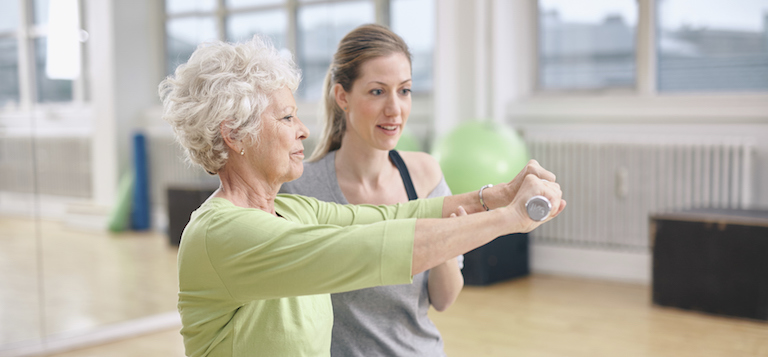Not all exercise is created equal when trying to maintain or build bone density, here’s your guide to finding the right exercise for you.1
Dubbed the “silent disease” because you can’t see it or feel it, osteoporosis can sound like a devastating diagnosis when you hear it. Pictures of hunched over backs and broken hips enter the imagination. But it doesn’t have to be that way. Once diagnosed with osteoporosis or osteopenia there are 2 main goals from a medical perspective:
- Minimize Bone Loss
- Prevent Fractures
You may have heard that exercise is important for osteoporosis. Studies have shown that you can build bone density through exercise or in the very least you can prevent further bone loss. It also helps prevent fractures by building muscular strength, core strength and balance. When performed with correct form it can also improve posture which helps decrease spinal compression reducing the risk for compression fractures of the spine that give people that stereotypical osteoporosis hunch.
But not all exercise is created equal for building or maintaining bone or helping prevent fractures. The type of exercise that is right for you depends on several factors:
- What types of exercise you ENJOY doing
- What your osteoporotic boney areas are (determined by a bone scan and typically hip, spine &/or wrist)
So what are the best forms of exercise for your bones?
For bone to be stimulated to grow it needs good nutritional support and it needs impact. If you’ve ever accidentally hit your shin against something and later felt a bump on the shin bone afterwards that’s because bone built up in that spot of the impact. I’m not suggesting abusing your bones! But doing activities with more impact help build bone more. That means swimming, being low impact, doesn’t help build bone and can actually promote a decrease in bone strength. But upright activities especially high impact aerobics, weight training, running, do help build bone. According to Robyn Fuchs, PhD, 2-4 hours/week of moderate activity decreases hip fracture risk by 25%. That’s HUGE!
Walking can also help maintain current bone density. I recommend trying walks on uneven terrain and with hills to add a little more impact and work to your muscles. You can check out the chart below to see what exercise research has shown to build bone and even what sites it builds bone in.
Exercise Type & Effect on Bone Building |
||
Exercise Type |
Effect on Bone Density |
Bone Building Sites |
| Swimming | No Increase or Decrease | None |
| Walking | Protects against further loss | Hip, Lumbar, Spine |
| Low-Impact Aerobic Exercise | Protects against further loss | Hip, Lumbar, Spine |
| High-Impact Aerobic Exercise | Increases | Hip, Lumbar, Spine |
| Weight Training | Increases | Hip, Lumbar, Spine Radius |
| Running | Increases | Hip, Lumbar, Spine |
| Squash (Racquet Sport) | Increases | Hip, Lumbar, Spine Radius |
Todd JA and Robinson RJ. Osteoporosis and Exercise (Review) Postgraduate Medical Journal (2003)320-330.
So how often should you perform your bone building exercise?
Ideally, one should perform 30-60 minutes of resistive and weight bearing activities 3 times per week.
Finally, it is important to add variety to your exercise routine. If you can find a few different things that you enjoy doing for exercise that is best. Our bodies adapt to daily routines, even exercise. If you don’t continue to “keep it guessing” by changing your exercise routine every 4-6 months you will maintain what you’ve gained in strength and bone density but you might limit that gain.
Our guest blogger this week is our rock star Dr. Sarah Petrich of Live Your LifeTM
 Dr. Petrich is also certified in Postural Restoration. She completed her Pilates rehabilitation training with Polestar Pilates and is Pilates Method Alliance Certified. She combines these two specialties to correct musculoskeletal imbalances and asymmetries, decrease pain and increase ease and efficiency of movement so clients become a stronger, balanced and relaxed self.
Dr. Petrich is also certified in Postural Restoration. She completed her Pilates rehabilitation training with Polestar Pilates and is Pilates Method Alliance Certified. She combines these two specialties to correct musculoskeletal imbalances and asymmetries, decrease pain and increase ease and efficiency of movement so clients become a stronger, balanced and relaxed self.
References:
Robyn Fuchs, PhD 2009 CSM Las Vegas
1Todd JA and Robinson RJ. Osteoporosis and Exercise (Review) Postgraduate Medicare Journal (2003)320-330.

